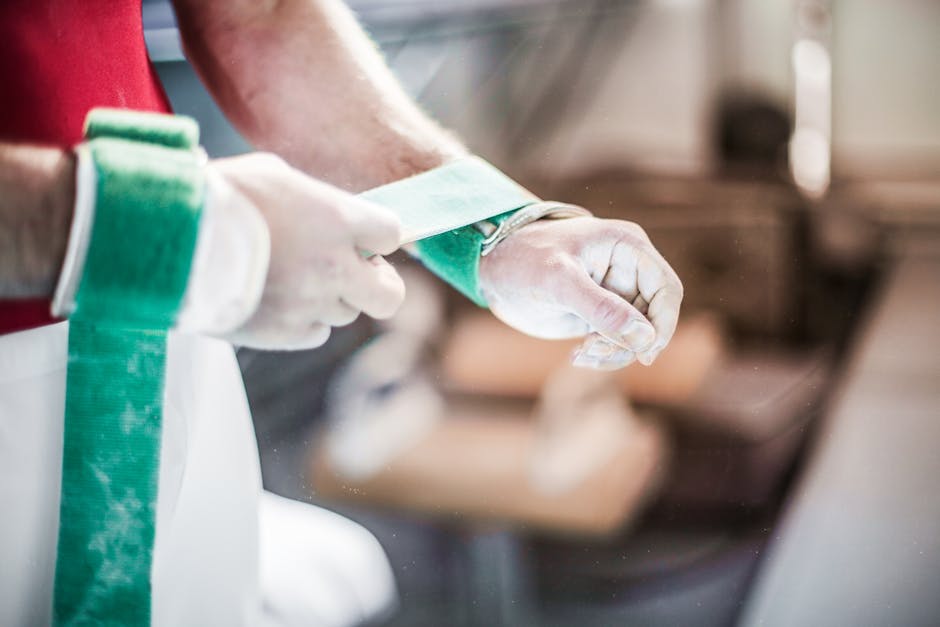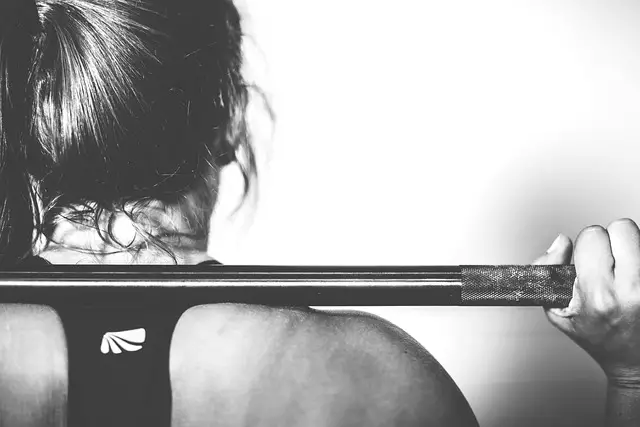Ah, the joys of weight lifting-induced elbow tendonitis. Who knew that building peak physical strength could also lead to peak physical pain? It’s like a twisted version of “no pain, no gain”. But don’t fret, fellow gym rats, because in this article we’ll be diving into the causes of this pesky injury and highlighting some treatment options that will have you flexing once again in no time. So grab some ice, pop an ibuprofen, and let’s get started.
Contents
- 1 Weight Lifting and Elbow Tendonitis: Understanding the Relationship
- 2 How Weight Lifting and Elbow Tendonitis are Best Buds
- 3 The Anatomy of Elbow Tendonitis: Causes and Risk Factors
- 4 Symptoms and Diagnosis of Elbow Tendonitis in Weight Lifters
- 5 Treatment Options for Weightlifting-Induced Elbow Tendonitis
- 6 Preventing Elbow Tendonitis from Interrupting Your Weight Lifting Regimen
Weight Lifting and Elbow Tendonitis: Understanding the Relationship
How Weight Lifting and Elbow Tendonitis are Best Buds
Nothing screams “fitness goals” like lifting heavy weights, getting pumped, and then having your elbow implode the next day. Ah, the joys of elbow tendonitis. It’s like your elbow is saying, “Don’t worry, bro. I got you. I know you were feeling too good about your gains, so I decided to mix things up.”
But why is elbow tendonitis such a popular guest at the weight lifting party? Well, for starters, lifting a heavy weight repeatedly puts a lot of strain on your elbow joint. And if you don’t have proper form, that strain increases even more. So, it’s like you’re inviting tendonitis over for a few reps of bicep curls and then wondering why it never leaves.
But wait, there’s more! Not only does weight lifting put a lot of strain on your elbow, but it also sucks the blood flow away from your tendons. And tendons, my friends, need blood flow like plants need sunlight. So, when they don’t get enough of it, that’s when the real party starts. And by party, I mean excruciating pain and inflammation. Yay.
- So, what’s the takeaway?
- Don’t skip out on proper form. Get a fitness coach or watch videos to nail that form.
- Don’t push yourself too hard, too fast. Start slow and gradually build up the weights.
- Stretch daily to improve blood flow and flexibility, and decrease your risk of injury.
- If you do happen to get elbow tendonitis, rest is your best friend.
- But if your elbow feels good and you’re ready to lift again, just remember to invite tendonitis over for a beer and pizza. After all, it’s practically family now.

The Anatomy of Elbow Tendonitis: Causes and Risk Factors
The Culprits
Elbow tendonitis is a tricky little creature. It sneaks up on you slowly, like a ninja in the night, until one day you wake up with a throbbing pain in your elbow and no idea what you did to deserve it. Well, fear not my friends, for I have uncovered the top culprits:
- Overusing your elbow doing repetitive motions like typing, tennis, or texting (yes, texting – apparently we have a disease now called “text elbow” – who knew?!)
- Not stretching your muscles before and after physical activity (because let’s be real, who has time for that?)
- Being old (sorry to break it to you, but apparently age IS a risk factor – who knew?!)
The Risk Factors
Now that we’ve identified the culprits, let’s take a look at the risk factors:
- Age (did I mention that one already? Oh well, it’s worth mentioning again)
- Gender (apparently being male increases your risk – sorry guys, I guess your days of throwing the football around are over)
- Health and fitness level (basically if you’re a couch potato, you’re doomed)
- Previous injuries or surgeries (because apparently our bodies are like a Jenga tower and one wrong move can make everything come tumbling down)
The Cure
So now what? Are we all destined to live a life of elbow pain and misery? Fear not, my friends, for there is hope!
The first step is to rest and allow your elbow to heal. I know, I know, easier said than done. But trust me, your elbow will thank you in the long run.
Next, consider physical therapy to strengthen your muscles and prevent future injuries. And if all else fails, there’s always the option of using a fancy elbow brace – because who doesn’t love a good accessory?
Symptoms and Diagnosis of Elbow Tendonitis in Weight Lifters
So you’ve been hitting the gym hard, trying to craft those bulging biceps and triceps to show off at the beach, but suddenly your elbow starts acting up. First, you attribute it to the intense arm curls you did yesterday, but slowly and surely, the pain increases, and you’re unable to lift those loads anymore. Well, we hate to break it to you, but you may be a victim of Elbow Tendonitis, a condition that affects weightlifters worldwide.
This condition is caused by inflammation of the tendons that connect the muscles of your forearm to the bone on the outer side of your elbow. As a result, you experience pain, soreness, and tenderness around the exterior of the elbow, which often increases when you bend your arm or try to lift anything. So, if those dumbbells or barbells that were once easy to lift are now taken up residence on the rack, it’s time to see a doctor.
But how do you know if it’s really elbow tendonitis? Well, here are some symptoms that you may experience:
- Pain or burning sensation on the outer side of the elbow
- Weakness in the grip or difficulty in lifting objects
- Stiffness in the elbow joint
- Tenderness when touched
- A clicking sound in the elbow joint when you move your arm
If you experience any of these symptoms, it’s time to visit a doctor who can diagnose your condition and recommend the right course of treatment. In some cases, rest, ice, compression, and elevation may help relieve some of your symptoms. However, if the condition is severe, you may need physical therapy or even surgery. So don’t take any chances and get yourself checked before you accidentally transform into the one-arm wonder!
Treatment Options for Weightlifting-Induced Elbow Tendonitis
Tired of Suffering from Weightlifting-Induced Elbow Tendonitis? Check Out These Treatment Options!
Feeling the pain from weightlifting-induced elbow tendonitis? Fear not, for there are a variety of treatment options available to help alleviate your discomfort. Here are three of the most effective and commonly utilized methods:
- Ice and Rest – Ice that bad boy and give it a rest! This classic approach can work wonders for reducing inflammation and letting your tendons heal. Bonus points if you freeze it in the shape of the middle finger to show your elbow who’s boss.
- Physical Therapy – Sometimes, we just need a little professional help. Physical therapy can teach you exercises and stretches to strengthen your tendons and prevent future injuries. Plus, you get to wear those fancy resistance bands and feel like a fitness guru.
- Medication – No shame in taking some painkillers or anti-inflammatory medication to get through the tough times. Just be sure to follow your doctor’s instructions and watch out for any potential side effects, like sudden urges to do the Macarena.
Remember, every person’s body is different and may respond better to one treatment option over another. So, try out a few and see what works for you. And, of course, always listen to your body and don’t push yourself too hard. Otherwise, you may end up with more injuries than gains. Happy lifting!
Preventing Elbow Tendonitis from Interrupting Your Weight Lifting Regimen
Are you tired of your elbow tendonitis getting in the way of your weight lifting goals? Well, fear not my fellow gym rat! I have compiled some tips and tricks to prevent this pesky injury from interrupting your gains train.
Firstly, don’t forget to warm up properly before your lifting session. This may seem like common sense, but let’s be honest, how many of us actually take the time to properly warm up? I’m not talking about a quick 5-minute stretch either. Take at least 10-15 minutes to warm up your joints, muscles, and tendons. Some great warm-up exercises for your elbows include arm circles, wrist rotations, and stretching your triceps and biceps.
Secondly, make sure to use proper form when lifting. This may seem obvious, but again, how many of us actually pay attention to our form? Using improper form can put unnecessary strain on your elbows, causing tendonitis. Remember to keep your elbows tucked in during exercises like bench press and shoulder press, and avoid locking out your elbows during any exercise.
Lastly, give your elbows some TLC. Get yourself a foam roller and roll out your forearms and triceps after your lifting session. This will help increase blood flow to the area, promoting faster healing and recovery. You can also ice your elbows for 10-15 minutes post-workout to decrease inflammation and reduce pain.
Following these tips will not only prevent elbow tendonitis but also make you feel like a true gym pro. Plus, you won’t have to dread missing out on your lifting sessions due to pesky injuries. So go on, lift strong and lift smart!
No More Tendons, All Gains
There you have it, folks! Don’t let weight lifting-induced elbow tendonitis hold you back from achieving your swole goals. Remember to properly warm up and stretch your arms before every workout, and gradually increase your weight and reps. But if you still feel that nagging pain in your elbow, don’t hesitate to seek professional help and treatment.
Stay safe, stay strong, and keep pumping that iron! Who cares about a little tendonitis when you have biceps the size of bowling balls? #thicc #gains #tendonitiswho








Leave A Comment